Digital Poster
Cartilage
ISMRM & ISMRT Annual Meeting & Exhibition • 10-15 May 2025 • Honolulu, Hawai'i

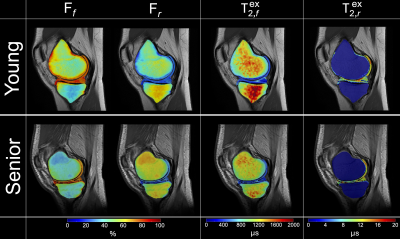 |
Computer Number: 81
2946. CEST
and ZAP MRI Reveal Age-Related Biochemical Changes in Knee Joint
Tissues
V. Malis, E. Smitaman, Y. Kassai, M. Miyazaki
UC San Diego, San Diego, United States
Impact: CEST
showed decreased hydroxyl (-OH) peak, suggesting age-related
glycosaminoglycan decline, while ZAP showed increase in
restricted protons fraction (Fr) in elders, suggesting
decreased hydration. This parametric MRI approach could
provide early biomarkers for diagnosing and monitoring joint
tissue alterations.
|
|
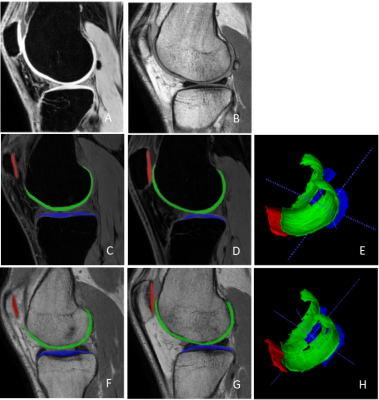 |
Computer Number: 82
2947. Consistency
Analysis of T2 Mapping and 3D-WATSc Techniques in Quantitative
Measurement of Knee Cartilage Volume
M. Wu, L. Xu, S. Fu, Y. Zhang, L. Han
Ningbo Medical Center LiHuiLi Hospital, Ningbo,China, China
Impact: The consistency between T2 mapping and 3D-WATSc
sequences in quantifying knee cartilage volume is good, and
the T2 mapping single sequence provides a reliable scanning
scheme for one-stop quantitative analysis of knee joint
cartilage morphology and function.
|
|
 |
Computer Number: 83
2948. Quantitative
Evaluation of Postoperative Status after Meniscal Repair Using
Synthetic Magnetic Resonance Imaging
L. Zhang, W. Mai, D. Zhang, C. Shi
the First Affiliated Hospital of Jinan University, Guangzhou , China
Impact: The post-surgery abnormal meniscus signals fail
to accurately distinguish the recurrent meniscus tears from
postoperative changes during recovery period using
conventional MRI. SyMRI can simultaneously provide contrast
weighted MRI and quantification, giving an objective
assessment of meniscus changes.
|
|
 |
Computer Number: 84
2949. 3D
Multi-shot Steady-State Free Precession EPI: a Feasibility Study
for Bright Fluid Cartilage Imaging
W. Liu, J. Jin, G. Buonincontri, M. D. Nickel, S. Balzer, L.
Kozhikkavil
Siemens Healthineers AG, Erlangen, Germany
Impact: The proposed EPI-SSFP sequences offer improved
efficiency and high-contrast imaging for cartilage
assessment, potentially enhancing clinical assessment of
joint effusions with reduced scan time and flexibility in
imaging parameters.
|
|
 |
Computer Number: 85
2950. Feasibility
of MR Fingerprinting in a Longitudinal Study of Knee Articular
Cartilage
D. Sitarcikova, V. Janacova, B. Hristoska, M. Gologan, M. A.
Cloos, P. Szomolanyi, S. Trattnig, V. Juras
Medical University Vienna, Vienna, Austria
Impact: This preliminary study suggests that MRF T2 mapping
is feasible in longitudinal studies and can reliably capture
changes in T2 over
time resulting from pathophysiological changes in knee
articular cartilage. This preliminary study will be extended
to larger population.
|
|
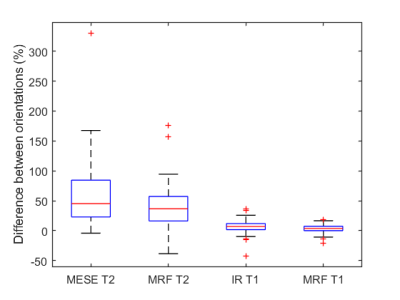 |
Computer Number: 86
2951. Orientation
Dependence of MRF-Derived qMRI Parameters in Human Articular
Cartilage
V. Kantola, V. Casula, M. Werner, M. Englund, M. Cloos, R.
Lattanzi, S. Saarakkala, M. Nissi, M. Nieminen
University of Oulu, Oulu, Finland
Impact: Improving the reliability of parametric mapping
using MRF can lead to a significant scan time reduction,
improving the throughput of examination in a clinical
setting.
|
|
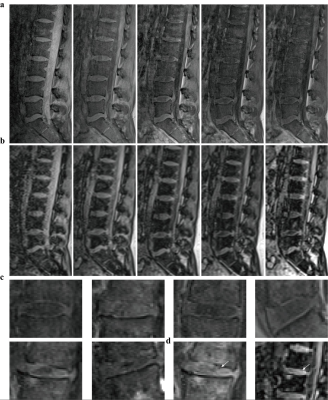 |
Computer Number: 87
2952. Application
of VIBE Sequences for Visualization and Assessing Cartilaginous
Endplate Damage in Low Back Pain Patients
H. Zhao, X. Zhao, X. Zhang, W. Du, T. Zhang, H. Zhang
The First Clinical Medical College of Lanzhou University, Lanzhou, China
Impact: This study highlights the potential of
conventional VIBE sequences for non-invasive, accurate
assessment of CEP damage, which may improve early diagnosis
and monitoring of IVD degeneration. It opens avenues for
further investigation into VIBE’s clinical application in
personalized treatment strategies for LBP patients.
|
|
 |
Computer Number: 88
2953. Effect
of knee positioning during MRI scan on segmented cartilage
volume and mean T2
V. Janacova, P. Szomolanyi, D. Sitarcikova, S. Trattnig, V.
Juras
Medical University of Vienna, Vienna, Austria
Impact: This study highlights the repeatability of
femoral cartilage volume and T2 values
in relation to patient positioning. Given the weak
correlations between position, volume, and T2 in
certain cartilage regions, to conduct a test-retest prior to
longitudinal studies is advisable.
|
|
 |
Computer Number: 89
2954. An
automated technique to estimate knee cartilage thickness for
femoral, tibial, patellar cartilages and menisci
D. Sundaran, L. Gomez, B. Nunes, J. Dholakia, M. Fung
GE HealthCare, Bengaluru, India
Impact: Cartilage thickness estimation holds significant
clinical value and the proposed method enables efficient
thickness estimation and visualization of all cartilage
compartments - femur, tibia, patella and meniscus in a
generic and less computationally intensive manner.
|
|
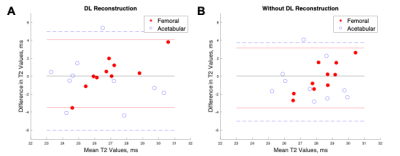 |
Computer Number: 90
2955. Short-Term
Reproducibility of Bilateral Quantitative Double Echo in Steady
State T2 Mapping of Hip Cartilage
L. Watkins, H. Zheng, M. Barbieri, F. Kogan
Stanford University, Stanford, United States
Impact: This work evaluates the repeatability of qDESS
in the hip, improving the ability of cartilage T2 imaging to
be incorporated into studies of hip cartilage microstructure
and osteoarthritis.
|
|
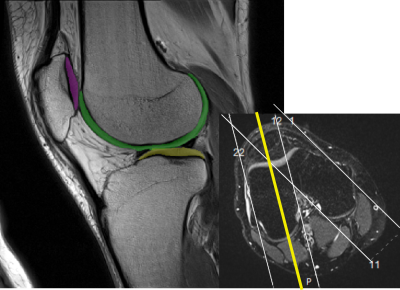 |
Computer Number: 91
2956. Reproducibility
of Knee Articular Cartilage T2 Mapping with Clinical MRI
Scanners: A Multi-site Multi-vendor Study
H. Leskinen, N. Pulkkinen, A. Esrafilian, J. Heikkinen, M.
Nissi
University of Eastern Finland, Kuopio, Finland
Impact: The results support T2 mapping in clinical
practice and encourage its use with clinical scanners. The
results will be directly utilized in the development of the
quality of MRI studies locally.
|
|
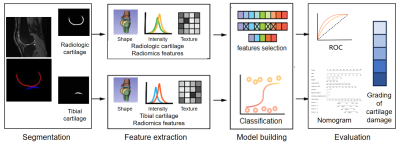 |
Computer Number: 92
2957. Grading
of Femoral and Tibial Cartilage Injuries in Knee Joint Based on
MRI Radiomics Features
Y. Wang, R. Zhang, J. Chen, Y. Rouzi, H. Tian, A. Tuohuti,
X. Liang, R. Yushan, L. Li, Z. Liu, Y. Wu
People’s Hospital of Xin jiang Uygur Autonomous Region, Xinjiang Uygur Autonomous Region, China
Impact: The constructed models provide a reliable method
for diagnosing cartilage damage severity, assisting in
designing personalized treatment plans for patients with
knee osteoarthritis.
|
|
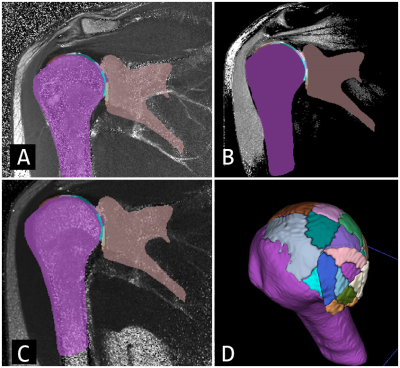 |
Computer Number: 93
2958. Automated
Pipeline for Shoulder Cartilage Segmentation and Extraction of
T2 and Texture Features
V. Juras, M. Schreiner, V. Janacova, P. Szomolanyi, E.
Raithel, R. Heule, O. Bieri, S. Trattnig
Medical University of Vienna, Vienna, Austria
Impact: This automated pipeline for shoulder cartilage
segmentation and extraction of T2 and texture features
offers a reliable, efficient approach to assess cartilage
health. The integration of T2 mapping techniques are paving
the way for quantitative cartilage evaluation in
musculoskeletal imaging.
|
|
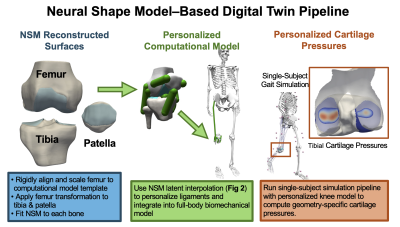 |
Computer Number: 94
2959. Orthopaedic
Digital Twins: Linking Cartilage Pressure to Osteoarthritis
Progression
A. Gatti, K. Marusich, A. Clouthier, C. Ong, C. Chu, A.
Esrafilian, S. Delp, G. Gold, F. Kogan, A. Chaudhari
Stanford University, Stanford, United States
Impact: Our fully automated Digital Twin estimates
cartilage pressures during gait that relate to future
cartilage thinning, and osteoarthritis progression. These
findings indicate that Digital Twins have the potential to
be implemented clinically, and hold promise for
understanding and treating osteoarthritis.
|
|
 |
Computer Number: 95
2960. Effect
of Resolution and DL-Denoising on In Vivo Repeatability of qDESS
T2 Relaxation Times
R. Shalit, A. Gatti, F. Kogan, M. Barbieri
Stanford, Stanford, United States
Impact: This study underscores the importance of
investigating the role of imaging parameters for qDESS T2
repeatability. With our setting, repeatability increased
with resolution, which was unexpected. Contrary to current
implementation trends, DLR-denoising did not positively
impact T2 reproducibility.
|
|
 |
Computer Number: 96
2961. Differences
in Hip Morphology and Cartilage Composition in Swimmers
Experiencing High Rotational Forces
H. Zheng, J. H. Lee, F. Kogan, L. Watkins
Stanford University, Stanford, United States
Impact: This study suggested that swim technique may be
related to hip morphology and cartilage in elite-level
swimmers. This population may be useful to study how
specific movements contribute to disease development.
|
The International Society for Magnetic Resonance in Medicine is accredited by the Accreditation Council for Continuing Medical Education to provide continuing medical education for physicians.